
Emergence of Chinese Charms
Symbols Begin to Appear on Chinese Coins
Many of the very earliest forms of Chinese money had inscriptions (legends) which identified the state or kingdom where they were cast. Some included their value as well, and examples of some of these early forms of money can be seen at Chinese Spade Charms.
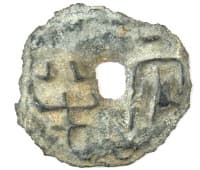 Gradually, other
notations such as dots, crescents, circles, lines and
blobs began to appear on Chinese coins. These simple
symbols can be "in relief" (yangwen 阳文), where they protrude above
the surface of the coin, or they may be carved, engraved
or incused (yinwen
阴文) into the coin.
Gradually, other
notations such as dots, crescents, circles, lines and
blobs began to appear on Chinese coins. These simple
symbols can be "in relief" (yangwen 阳文), where they protrude above
the surface of the coin, or they may be carved, engraved
or incused (yinwen
阴文) into the coin.While these simple symbols are not well understood, they are believed to represent stars, moons, suns, numbers, etc.
A theory on the meaning of these symbols is discussed at Ancient Chinese Charm Symbols: Star, Moon, Cloud and Dragon.
These early symbols on Chinese coins were the beginning of the evolution that eventually resulted in the "charms" and "amulets" of the next 2,000 years.
Presented below is a brief description of these first symbols as they appeared on early Chinese coins.
Dots are "Stars"
 These
dots are usually small and are raised above the face of
the coin the same as any Chinese characters or rims
surrounding the edge of the coin or the central
hole. This means that these symbols had to have been
intentionally carved into the mold used to cast the coin.
These
dots are usually small and are raised above the face of
the coin the same as any Chinese characters or rims
surrounding the edge of the coin or the central
hole. This means that these symbols had to have been
intentionally carved into the mold used to cast the coin.In some cases, the dots are below the surface of the coin which means they had to have been engraved or incused on the coin after it was cast.
Dots can be found on both the obverse and reverse of coins. Many times there is only one dot but some coins can have several.
While it would be difficult to determine when the very first dot appeared on Chinese coinage, they became more frequently seen on the ban liang (banliang 半 两) coins of the Western Han Dynasty (206 BC - 8 AD).
These dots are usually understood to represent "stars" and their meaning is discussed in more detail at Ancient Chinese Charm Symbols: Star, Moon, Cloud and Dragon.
Crescents are "Moons"
 This is an example of a moon or
crescent and the Chinese variously refer to these
marks as "moon lines" (yuewen 月纹), "nail lines" (jiawen 甲纹), or
"moon marks" (yuehen
月痕).
This is an example of a moon or
crescent and the Chinese variously refer to these
marks as "moon lines" (yuewen 月纹), "nail lines" (jiawen 甲纹), or
"moon marks" (yuehen
月痕).Crescents are found both on the obverse and reverse of coins.
While the single crescent is the most common, coins with two, three, or four crescents also exist.
Crescents are believed to symbolize the "moon" and were first seen on ban liang coins of the Western Han Dynasty.
Circles are "Suns"

A small circle is believed to represent the "sun" and is occasionally seen on early Chinese coins such as the example at the left found on an Eastern Han dynasty wu zhu coin.
Numbers
Vertical,
slanted and horizontal lines, sometimes
single and sometimes multiple,
frequently appear on wu zhu
coins, particularly those from the
Eastern Han Dynasty (25-220 AD).
These lines are generally believed to be
"numbers" and examples would
include "一" for "one", "二" for "two" and "三"
for "three".
 Larger numbers are usually
written in their respective Chinese character
such as "six" (liu 六), "nine" (jiu 九),
"ten" (shi
十), etc.
Larger numbers are usually
written in their respective Chinese character
such as "six" (liu 六), "nine" (jiu 九),
"ten" (shi
十), etc.These "numbers" do not appear to express the "value" or "worth" of the coin. For example, three horizontal or slanting lines does not mean the coin is worth three coins, and the Chinese character "ten" (shi 十) does not mean the coin has a token value of ten regular coins.
Instead, current speculation is that these "numbers" were used to indicate a "quantity" or "measure" although it is unclear in what capacity.
Counting Rod Numbers
In addition to the standard number system discussed above, the ancient Chinese also used another numeral system. This system was based on rods (short sticks) which, presumably, could be placed in various positions within a special box. By placing the rods in different positions and orientations, mathematical calculations such as adding and subtracting could be done similar to what could be done with the abacus which was invented much later.
These "rods" were called "counting rods" and their various configurations represented "rod numbers" or "rod numerals".
 For example, the
number "6" is represented by a symbol that
resembles a "T" as illustrated here.
For example, the
number "6" is represented by a symbol that
resembles a "T" as illustrated here.As already mentioned, it is believed that this system of expressing numbers was mainly used in calculations while the Chinese characters mentioned in the section above were used in writing.
However, the "ten spades" coins cast (10-14 AD) during the reign of Wang Mang of the Xin Dynasty (7-23 AD) display rod numbers as part of their inscriptions so the precedence was established, at least by this time, for their appearance on wu zhu coins of the Eastern Han and later dynasties.
Remnants and variations of this old rod-based numbering system, sometimes referred to as "commercial style", continue to exist even today. The Suzhou numeral system (suzhou mazi 苏州码子), also known as the "flower" or "fancy" numeral system (huama 花码), is similar and is sometimes still encountered in old Chinese markets.
As mentioned, some wu zhu coins, particularly those cast during the Eastern Han and later, have symbols which appear to be "rod numbers". Several examples of these Chinese coins are displayed in the section below entitled "Wu Zhu Coins with Rod Numbers (Numerals)".
 Some of these characters, such
as 小 (xiao), 平 (ping),
and 工 (gong),
were probably used to indicate the scope or
limits in which the coins were intended to
circulate. Xiao (小) means
"small", ping (平) means "level"
such as a "plain", and gong (工)
means "work" or "industry". Perhaps
these coins were mainly meant to circulate in
designated areas.
Some of these characters, such
as 小 (xiao), 平 (ping),
and 工 (gong),
were probably used to indicate the scope or
limits in which the coins were intended to
circulate. Xiao (小) means
"small", ping (平) means "level"
such as a "plain", and gong (工)
means "work" or "industry". Perhaps
these coins were mainly meant to circulate in
designated areas. Other Chinese characters such
as 王 (wang) and 田 (tian) are
surnames or family names. The names may
indicate the person or family that possessed
or perhaps even cast the coins.
Other Chinese characters such
as 王 (wang) and 田 (tian) are
surnames or family names. The names may
indicate the person or family that possessed
or perhaps even cast the coins.Auspicious symbols such as the swastika can also be found on wu zhu coins.
Official and Local Cast Coins
A very large number of these wu zhu coins with dots, crescents, circles, numbers and added characters are poorly made and were most probably locally or privately cast.
Presented below are examples of some of the symbols discussed above that can be found on such early forms of Chinese money such as the round coins of the Zhou Dynasty, the ban liang and wu zhu coins of the Qin and Han Dynasties, and the Wang Mang coins of the Xin (Hsin) Dynasty.
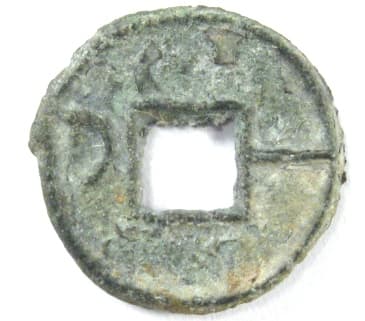
This small coin was one of the first examples of "round" coins from the Zhou Dynasty.
It was also one of the first coins to have a square center hole instead of a round one.
The coin was cast in the ancient state of Yan during the period 300-220 BC.
The inscription is read right to left as yi hua (一化).
The inscription was previously believed to be yi dao (一刀) or "one knife".
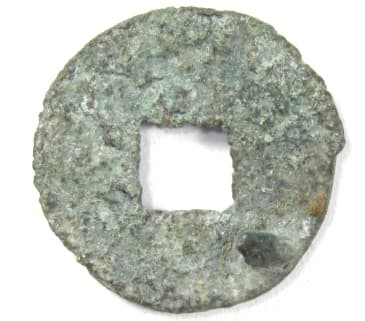
These coins always have a plain and very flat reverse side.
It is very rare to see any marks or symbols on the reverse side of these coins. To the best of my knowledge, only a very few coins with the Chinese character ji (吉) or gong (工) on the reverse have ever been found.
What is distinctive about this particular coin is the very large "dot" (xing 星) at the five o'clock position. This dot is just inside the rim and protrudes almost 0.75 mm above the face of the coin.
Given the method of casting at the time, this "dot" would almost certainly have been intentional.
Dots on coins are believed to symbolize "stars". This tradition of placing such a symbol on coins, which must have begun about the time this coin was cast, would continue for the next two millennia.
This coin has a diameter of 19 mm and a weight of 1.5 grams.
Ban Liang (Pan Liang) Coins
Emperor Qin Shi Huang conquered the various "warring states" and unified China in 221 BC. To consolidate central power, he proceeded to standardize the various scripts, weights and measures that existed among the various states.
In order to centralize and standardize the monetary system, he abolished the existing forms of money. He stipulated that the monetary system would consist of a two tier system with a "higher" form of currency (shang bi 上币) made of gold and a "lower" form of currency (xia bi 下币) made of bronze.
The "lower" form of currency was established as a round bronze coin, having a square hole in the middle, with a value of a half "tael" or half liang (两). A "liang" consisted of 24 zhu (铢) so this coin worth half (ban 半) a "liang", or 12 zhu (铢), is known as a ban liang (banliang 半 两) coin.
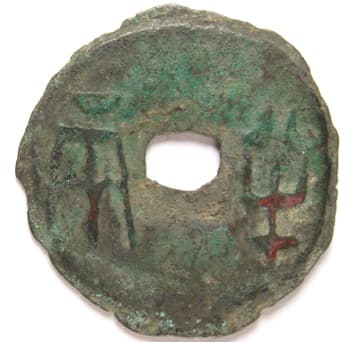 The ban liang coin had
already been circulating in the State of Qin during the
"Warring States" period before the unification of the
country. These coins had a diameter of roughly 30-34
mm and a weight of around 8 grams, although both smaller
and lighter, as well as larger and heavier specimens
exist. The inscriptions were mostly written in an
old archaic calligraphic style known as "small seal
script" (xiaozhuan
小篆) with some written in "large seal script" (dazhuan 大篆).
The ban liang coin had
already been circulating in the State of Qin during the
"Warring States" period before the unification of the
country. These coins had a diameter of roughly 30-34
mm and a weight of around 8 grams, although both smaller
and lighter, as well as larger and heavier specimens
exist. The inscriptions were mostly written in an
old archaic calligraphic style known as "small seal
script" (xiaozhuan
小篆) with some written in "large seal script" (dazhuan 大篆).A newly discovered variety of ban liang from the State of Qin is discussed at "Drilled Hole" Ban Liang Coins.
An extremely rare ban liang made of silver can be seen at State of Qin Silver Banliang Coin.
The coin at the left is an example of a ban liang from the Qin Dynasty. The inscription is in seal script with long and narrow characters written in a primal freehand style.
As can be seen, these early ban liang coins were not well finished. The coin is not quite round. The rim has not been filed smooth. The small center hole is more round than square.
This ban liang has a diameter of 31 mm and a weight of 5.6 grams.
The various ban liang coins produced after the unification varied greatly in size and weight and are therefore difficult to identify definitively as to date and place of casting.
The Qin Dynasty was short-lived (221-207 BC), and was followed by the Western Han Dynasty (206 BC - 24 AD) which continued to cast ban liang coins. These coins, however, gradually decreased in both size and weight.
 During the transition from the Qin to the
Han dynasties, a very few extremely small ban liang coins were
produced.
During the transition from the Qin to the
Han dynasties, a very few extremely small ban liang coins were
produced.The ban liang shown at the left, with the inscription in seal script, appears to have a large lead content and is the smallest ban liang coin I have seen.
The actual diameter is only 5 mm and the weight is a mere 0.12 gram!
 Additionally, during the early Han
(200-180 BC), the rich and powerful were ordered to
privately cast ban
liang coins. These coins tended to be very
small and light. Some were as small as 10 mm and
weighing only about 0.4 gram. Because of their
diminutive size and weight, they are referred to as "elm
seed" (yu jia 榆荚)
ban liang.
Additionally, during the early Han
(200-180 BC), the rich and powerful were ordered to
privately cast ban
liang coins. These coins tended to be very
small and light. Some were as small as 10 mm and
weighing only about 0.4 gram. Because of their
diminutive size and weight, they are referred to as "elm
seed" (yu jia 榆荚)
ban liang.An example of an elm seed ban liang is shown here. The diameter is 17.5 mm and the weight is 0.49 gram.
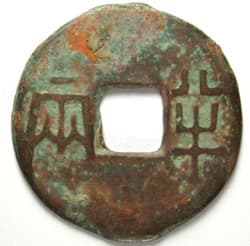
In the fifth year (186 BC) of the reign of Empress Lu, the official ban liang was cast at 8 zhu (铢). These coins were thin with a diameter averaging about 26-30 mm and a weight of approximately 4.8-5.3 grams. The inscription was now written in the "official script" (li shu 隶书) of the Han Dynasty.
The coin at the left is probably an early, and slightly larger, example of a Han Dynasty 8 zhu ban liang. The diameter is 32 mm and the weight is 7.2 grams.
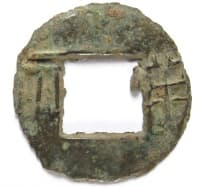
In the sixth year (182 BC) of the reign of Empress Lu Hou, the government cast ban liang coins of 2.4 zhu (铢). These coins were only about 20 mm in diameter and were distinguished by a large square hole. Because they were in reality only one-fifth of a ban liang, they are usually referred to as "5 parts" (wu fen 五分) ban liang coins.
This is an example of a 5 parts ban liang. The coin has a diameter of 22 mm and a weight of 1.6 grams.
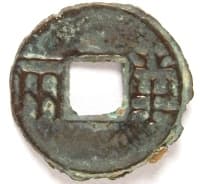 In the fifth year (175 BC) of
the reign of Emperor Wen, the ban liang was cast at a value of 4 zhu (铢).
These
coins
typically
have
a
diameter
of about 23-25 mm and a weight of 3 grams or less.
Based on the calligraphy, the 4 zhu ban liang at the left (24 mm and
2.3 grams) is probably an early example. Some 4 zhu ban liang coins have
an outer rim. A far fewer number have both an
outside rim as well as an inside rim around the square
hole.
In the fifth year (175 BC) of
the reign of Emperor Wen, the ban liang was cast at a value of 4 zhu (铢).
These
coins
typically
have
a
diameter
of about 23-25 mm and a weight of 3 grams or less.
Based on the calligraphy, the 4 zhu ban liang at the left (24 mm and
2.3 grams) is probably an early example. Some 4 zhu ban liang coins have
an outer rim. A far fewer number have both an
outside rim as well as an inside rim around the square
hole.A number of 4 zhu ban liang coins display various markings such as dots, lines, numbers and symbols. Some have their inscriptions reversed. A few rare specimens have additional characters such as tai chang (太常) and shang wen (上问). Examples of some of these unusual Chinese coins can be seen below.
Even though casting of ban liangs ceased in the fourth year (119 BC) of the reign of Emperor Wu of the Western Han to be replaced with the new wu zhu (五 铢) coin, ban liang coins still continued to circulate as currency.
Shown below are examples of less commonly seen ban liang coins including some which display unusual features such as dots, crescents, lines, numbers and reversed inscriptions.
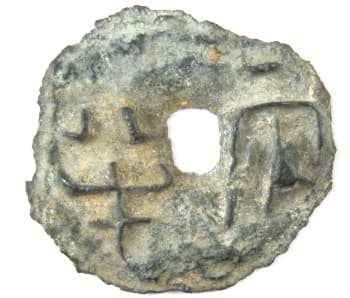 As mentioned, the
very first ban liang
(pan liang)
coins were actually cast in the state of Qin perhaps as
early as 378 BC. At that time, a Chinese "ounce"
(tael) or liang
(两) weighed about 16 grams so
early ban liang
coins had a weight of about 8 grams.
As mentioned, the
very first ban liang
(pan liang)
coins were actually cast in the state of Qin perhaps as
early as 378 BC. At that time, a Chinese "ounce"
(tael) or liang
(两) weighed about 16 grams so
early ban liang
coins had a weight of about 8 grams.The ban liang at the left is slightly irregular in shape, has a small central hole and large seal script characters. These are all characteristics of a Qin Dynasty banliang but this coin is smaller and lighter. It may in fact be a Qin-Han transitional piece.
These coins usually have the ban (半) character on the right and the liang (两) character on the left so that the inscription is read right to left as ban liang (半两).
The striking feature of this coin, however, is that the two Chinese characters are reversed so that the inscription (legend) actually reads liang ban (两半). In Chinese, this reversal of characters is referred to as chuan xing (传形).
It is unknown, however, what significance or symbolism might be implied by reversing the two characters.
This ban liang coin, which appears to have a high lead content, has a diameter of 21 mm and a weight of 2.4 grams.
 The ban
liang at the left is another chuan xing (传形)
specimen which means the two characters in the inscription
are reversed.
The ban
liang at the left is another chuan xing (传形)
specimen which means the two characters in the inscription
are reversed.The legend reads liang ban (两半) instead of ban liang (半两).
This coin is also interesting because one can still see casting sprue at the upper left edge of the coin. This protruding metal is the remnant of the passageway that the molten bronze flowed through to fill the mold and form the coin.
After coins were removed from the mold, they were stacked onto a long square metal rod. The hole in the coin and the metal rod were both square so that the coins would not rotate while a worker used a file to remove any metal stubs (sprue) from the edges that remained after the casting in order to make the coins round.
This ban liang has a diameter of 23 mm and a weight of 2.5 grams.

This is a Qin Dynasty ban liang with a special characteristic.
Just above the square hole is a dot or "star".
This coin has a diameter of 27.9 mm and a weight of 5.5 grams.
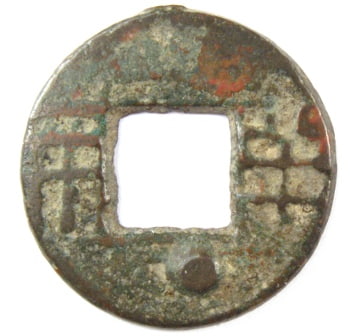
This is a "4 zhu" ban liang (pan liang) coin cast during the Western Han.
Its most distinctive feature is the very large dot or "star" below the square hole.
The diameter of the coin is 22.7 mm and the weight is 2.6 grams.
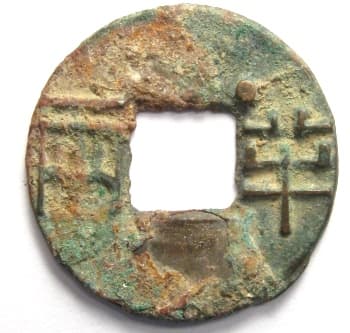
This is another ban liang displaying a very well formed dot or "star".
In this case, the star is above the ban (半) and near the upper right corner of the square hole.
It is not known what the significance is of the various positions of "stars" on these coins.
This ban liang has a diameter of 25 mm and a weight of 2.6 grams.
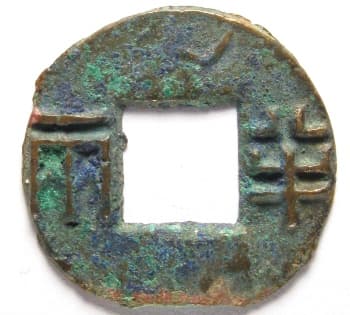
The earliest appearance of moons or crescents on Chinese coins occurred on ban liangs of the Han Dynasty.
There is a "moon" above the hole on this ban liang.
The coin has a diameter of slightly more than 24 mm and a weight of 2.8 grams.
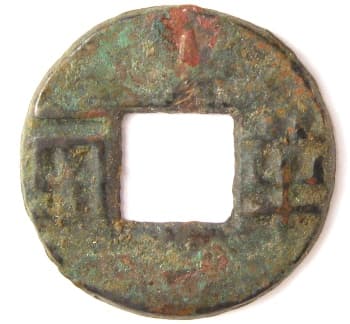
This is another 4 zhu ban liang from the Western Han.
Above the square hole is a short vertical line which, by coincidence, is highlighted with red patina.
The line is raised above the field of the coin so it had to have been intentionally engraved into the mold from which the coin was cast.
The diameter is 23.5 mm and the weight is 2.8 grams.
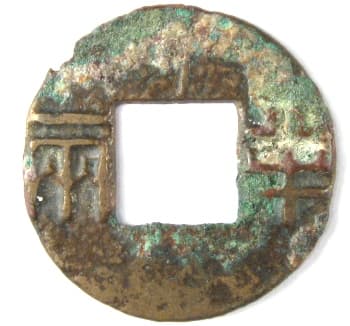
This ban liang has a slightly slanted line just above the hole.
The coin has a diameter of 24.7 mm and a weight of 2.7 grams.
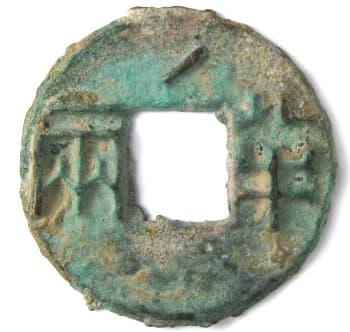
The coin at the left is another Western Han ban liang.
Above the hole is a very distinct slanting line. This slanted line protrudes well above the surface of the coin.
Please also note that the hole is more rectangular than square. This is a characteristic of a very small number of 4 zhu ban liang coins cast during the Han Dynasty to be used as charms. It is believed that the rectangular hole made it more convenient to wear or hang the coin from the waist.
This ban liang has a diameter of 25 mm and a weight of 3.2 grams.
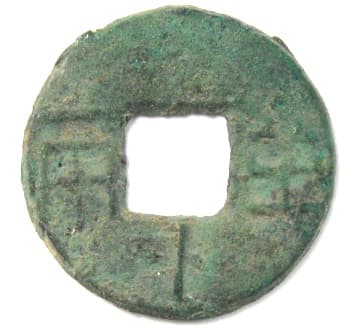
The ban liang at the left has a very prominent vertical line below the square hole.
The diameter of the coin is 24 mm and the weight is 2.8 grams.

This is a ban liang with two vertical lines below the square hole.
The coin has a diameter of 23.7 mm and a weight of 3.2 grams.
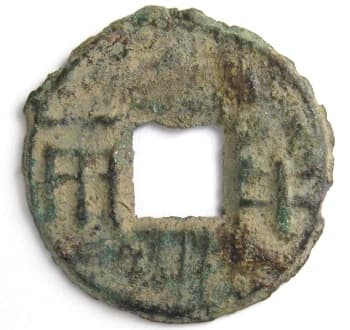
This ban liang is distinguished for having three vertical lines below the square hole.
The coin has a diameter of 24 mm and a weight of 2.8 grams.
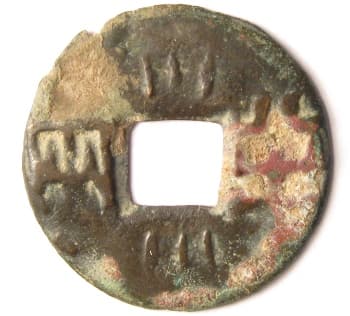
At the left is another example of a Western Han Dynasty ban liang (banliang 半 两).
This coin is unusual because it has three vertical lines (shu 竖) above, and three vertical lines below, the square hole.
The symbolism remains unknown but the lines could represent stars, numbers, the place or time of casting, etc.
This coin has a diameter of 24.5 mm and a weight of 2.7 grams.
 The ban
liang at the left has a horizontal line above the
square hole.
The ban
liang at the left has a horizontal line above the
square hole.If you observe very carefully, however, you will also notice that there is another horizontal line running parallel to this line but below the square hole.
The areas above and below the square hole are slightly raised which, along with the horizontal lines, are characteristic of a type of 4 zhu ban liang cast by Deng Tong (邓通).
Deng Tong was a wealthy businessman who had a close personal relationship with Emperor Wen. Stories from ancient times hint that Emperor Wen was fond of men and that Deng Tong was one of his favorites. During a 3 year period, Emperor Wen allowed Deng Tong to privately cast ban liang coins. In order to differentiate his coins from those officially cast, Deng Tong added extra metal above and below the square hole of the coins. Since there was "more" metal (value), these coins were said to bring more "happiness" (duo fu 多福).
The diameter of this coin is 24.5 mm and the weight is 2.7 grams.
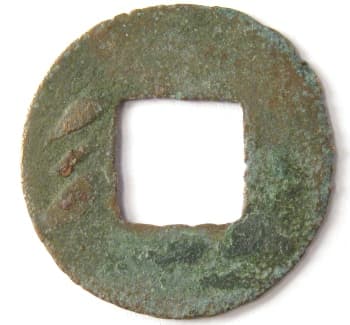
This is another Western Han ban liang.
The reverse side displays three slanting lines to the left of the square hole.
The coin has a diameter of 24 mm and a weight of 1.8 grams.
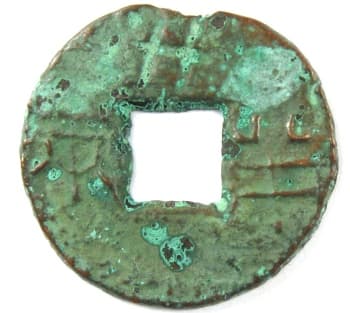
The ban liang at the left has the Chinese symbol for "twenty" (ershi 二十) incused or engraved above the square hole.
Current speculation is that numbers like this did not refer to the "value" of the coin but rather to some still unknown "quantity" or "measure".
The diameter of the coin is 25 mm and the weight is 3.3 grams.
Wu Zhu Coins
Wu means "five" (5) and zhu means "grain". The "grain" was an ancient Chinese unit of weight equal to 100 grains of millet. A "five grain" or "five zhu" coin would weigh about 4 grams.
As mentioned in the section above, twenty-four zhu was equal to one liang so a true ban (half) liang coin would equal 12 zhu. As described above, however, the ban liang gradually became smaller and lighter over its history.
The "five zhu" or wu zhu coin replaced the ban liang coin. Huge quantities of wu zhu coins were produced during the Western Han Dynasty alone and wu zhu coins continued to be cast throughout the dynasties that followed until they were finally replaced by the kai yuan tong bao coin in 621 AD at the beginning of the Tang Dynasty. The wu zhu was used for over 700 years making it the longest used coin in Chinese history.
As you might expect, there are numerous varieties of wu zhu coins. Unfortunately, many of these varieties cannot be directly attributed to a specific time and place of casting.
Nevertheless, a brief description of some of the major varieties will be presented here.
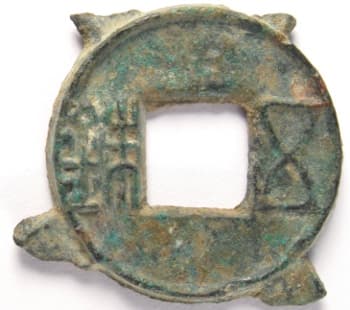 In
118
BC
during
the
Western
Han, the Commanderies (jun 君) and the Principalities (guo 国) were
ordered to cast wu
zhu coins. These coins are
appropriately referred to as jun guo wu zhu
(君国五
铢). A
rim was added around the square hole on the
reverse side of the coin in order to prevent
people from scraping off metal. Also, many of
these early wu
zhu coins tended to have unfiled edges
resulting in a rough circumference.
In
118
BC
during
the
Western
Han, the Commanderies (jun 君) and the Principalities (guo 国) were
ordered to cast wu
zhu coins. These coins are
appropriately referred to as jun guo wu zhu
(君国五
铢). A
rim was added around the square hole on the
reverse side of the coin in order to prevent
people from scraping off metal. Also, many of
these early wu
zhu coins tended to have unfiled edges
resulting in a rough circumference.The coin at the left is a jun guo wu zhu (君国五 铢) coin which clearly illustrates that sometimes even remnants of the metal sprue (stubs) from the casting process were not filed off. This particular coin has a maximum diameter of 33.3 mm and a weight of 5.8 grams. (For additional information on how Chinese coins were cast, please visit Chinese Coins with Flower Holes.)
In the year 115 BC of the Western Han, Emperor Wu ordered that wu zhu coins be cast with a value equal to five coins. These coins were called chi ze wu zhu (赤仄五 铢) and are also known as zhong guan chi ze (锺官赤 仄). Chi ze means "red" or purple edge since, after being removed from the mold, the edges of these coins were filed so that the copper color of the bare metal showed through. The wu (五) character on these coins tends to be composed of fairly straight lines.
The exclusive authority to produce coins returned to the central government beginning in the year 113 BC with wu zhu coins cast by the Three Offices of Shang Lin (shang lin san guan 上林三官). Unlike the chi ze coins which had an unrealistic value of being equal to five coins, the shang lin san guan coins were valued as equal to one coin. Most of these coins have a raised line above the square hole on the obverse side.
The wu zhu coins cast during the reign of Emperor Xuan (73-49 BC) are characterized by a smaller wu character with strokes that are slightly crooked and not extending to the ends of the top and bottom horizontal lines.
Since this was the incipient period for the emergence of symbols on Chinese charms, some of these Western Han coins also displayed dots or "stars", half moons on the interior rim, and other auspicious symbols.
The casting of wu zhu coins temporarily ceased during the short-lived Xin Dynasty (7-23 AD) with the reign of Wang Mang but then resumed under the reign of Emperor Guang Wu (25-56 AD) of the Eastern Han Dynasty (25-220 AD).
As already stated, beginning with the Eastern Han Dynasty and continuing until the Tang Dynasty, it is very difficult to identify where and when many wu zhu coins were cast. This is because coins at this time were cast in bronze molds and, since these molds would last a long time, they continued to be used over and over again by subsequent dynasties.
However, wu zhu coins from these dynasties are among the most interesting. This is because many display such "auspicious" symbols as stars, suns, moons, etc.
A variety of these wu zhu coins displaying reverse inscriptions, stars, suns, moons, numbers, rod numerals, lines, Chinese characters and symbols are discussed below.
Wu Zhu Coins with Reverse Inscription
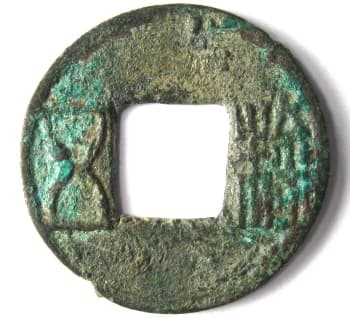
Similar to the ban liang coins, some wu zhu (五 铢) coins were cast with the inscription (legend) reversed.
Normally, the wu (五) is on the right and the zhu (铢) is on the left.
On these "reverse inscription" coins, however, the wu (五) is on the left and the zhu (铢) is on the right, as is the case with the coin pictured here. The Chinese term for this reversal of characters is chuan xing (传形).
Unfortunately, the meaning or significance of reversing the two characters is still unknown.
This coin has a diameter of 24.5 mm and a weight of 2.8 grams.
Wu Zhu Coins with Dots or "Stars"

This wu zhu has the inscription written in the normal manner, i.e. with the wu (五) on the right and the zhu (铢) on the left.
There is a very well formed dot or "star" above the upper left corner of the square hole.
The "star" actually has a small tail which makes it appear similar to a shooting star or a "tadpole lucky cloud".
The coin has a diameter of 25.7 mm and a weight of 3.2 grams.
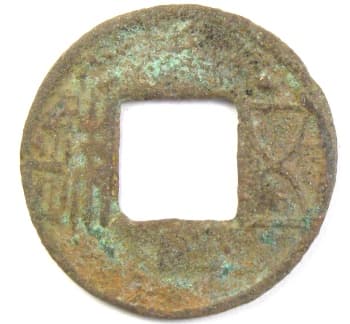
This wu zhu has a dot or "star" located just above the wu (五) character at the right of the square hole.
The coin has a diameter of 25.8 mm and a weight of 2.4 grams.
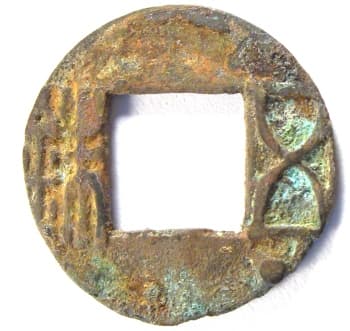
The wu zhu displayed at the left has a large dot or "star" below the character "wu" (五) to the right of the square hole.
The diameter of the coin is 21.6 mm and the weight is 1.4 grams.
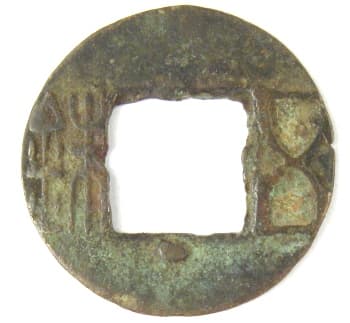
The wu zhu at the left has a very large dot or "star" just below the square hole.
Also, the coin has no outer rim. For this reason, the coin is known as the "female coin" (gong shi nu qian 公式女钱).
The coin was cast during the Southern Dynasties (420-589 AD) in the year 502 AD by Emperor Wu of the Liang Dynasty (502-557 AD).
The diameter of the coin is 22.5 mm and the weight is 1.4 grams.
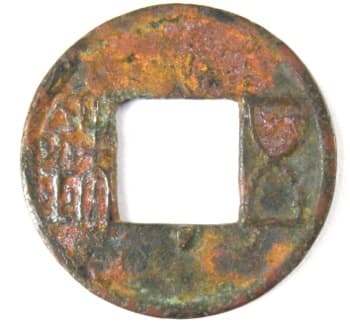
This is an Eastern Han (25-220 AD) wu zhu coin with a "star" below the hole.
In this specimen, however, the dot is not round but triangular in shape.
The coin has a diameter of 25.8 mm and a weight of 2.7 grams.

On the reverse side of this wu zhu is a single star located to the left of the hole and near the rim.
The coin has a diameter of 26 mm and a weight of 3.1 grams.

This wu zhu coin has a large triangular dot just above the hole.
Also, centered between the lower edge of the hole and the rim is a smaller, but well-formed, round dot.
The coin has a diameter of 22 mm and a weight of 1.8 grams.
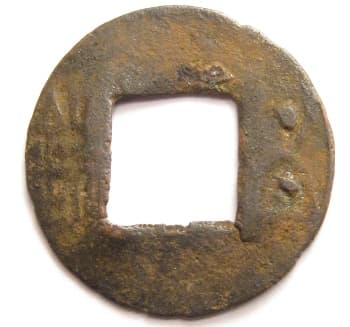
The coin at the left is a well-known variety of Eastern Han wu zhu coins.
As you can see, there are two dots inside the wu (五) character on the right which gives the appearance of two eyes staring at you.
In Chinese, this variety is known as chang ming wu zhu (长明五铢).
The coin has a diameter of 23.7 mm and a weight of 1.7 grams.
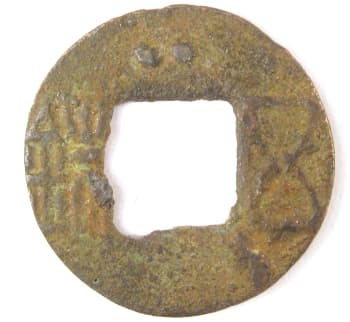
This wu zhu coin has two very distinct dots or "stars" on its obverse side above the square hole.
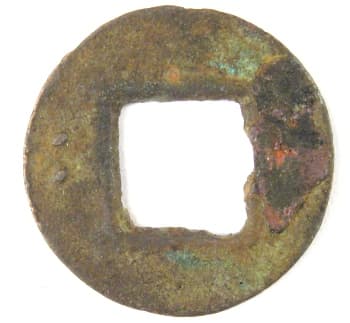
If you observe closely, you will see that this same coin also has two "stars" to the left of the square hole on its reverse side.
The coin's diameter is 22.6 mm and its weight is 2.3 grams.
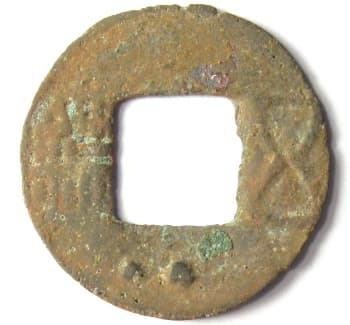
This Eastern Han wu zhu coin is distinguished by having two prominent dots or "stars" on its obverse side below the square hole.
The diameter of the coin is 23.3 mm and the weight is 1.8 grams.
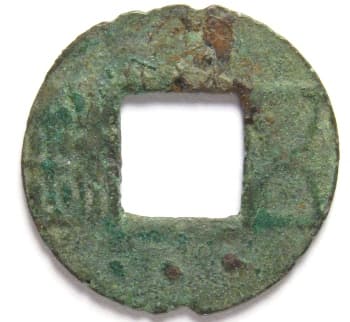
The wu zhu at the left is also from the Eastern Han and displays three dots or "stars" below the square hole on its obverse side.
The coin has a diameter of 23 mm and a weight of 1.5 grams.
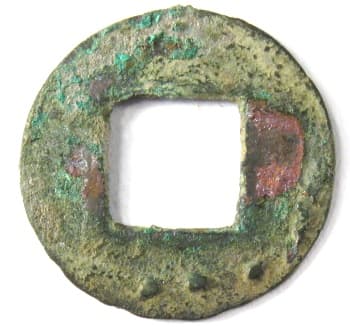
This is the reverse side of an Eastern Han wu zhu with three stars below the square hole.
The diameter is 23 mm and the weight is 2 grams.
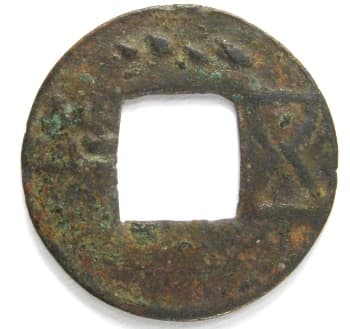
The wu zhu to the left has four large slanting dots or stars on its obverse side above the square hole.
The coin has a diameter of 24.2 mm and a weight of 2 grams.
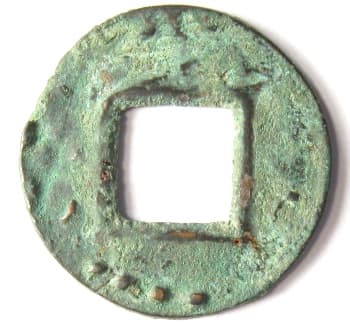
The wu zhu
coin shown here was probably also cast during the
Eastern Han Dynasty.
It has what appears to be a series of four
"stars" on its reverse side below the square hole.
Also, just above and to the left of the
"stars" is a small crescent which may be a "moon".
As is the case with the very oldest coins
with charm-like symbols, the exact meaning and intent
are unclear.
The coin has a diameter of 24.5 mm and a
weight of 2.8 grams.
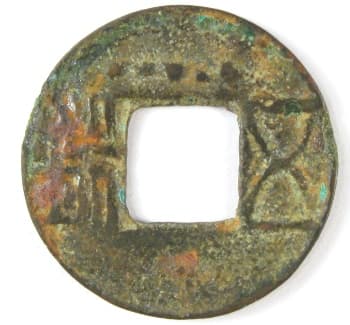
The Eastern Han wu
zhu displayed here has five stars above the square
hole.
The coin has a diameter of 24 mm and a weight of 2.8
grams.
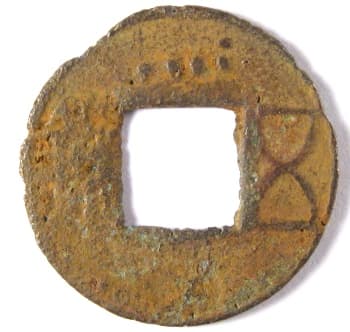
This wu zhu
also has five dots or stars above the hole but in a
different configuration.
The diameter is 25 mm and the weight is 2.1 grams.
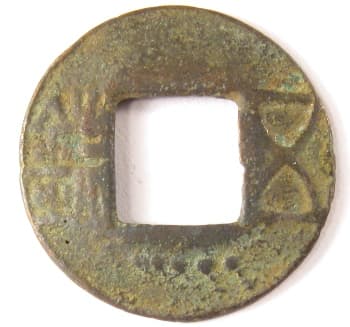
This Eastern Han wu zhu has a series of five stars
below the square hole on its obverse side.
Wu Zhu Coin with Circle or "Sun"
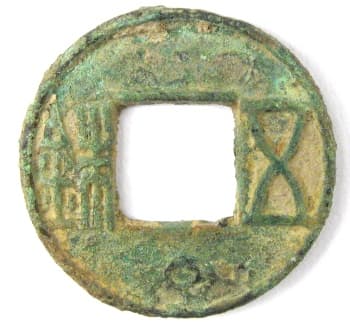
The nicely cast wu
zhu coin at the left has a "circle" below the
square hole.
Circles are believed to symbolize the "sun".
This coin has a diameter of 25.2 mm and a weight of 4.1
grams.
Wu Zhu Coins with Numbers
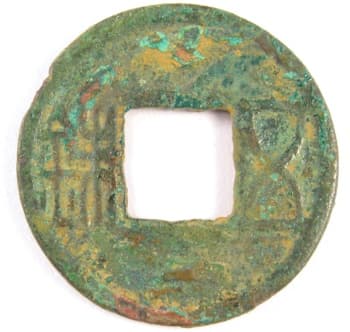
This is another Eastern Han wu zhu coin.
This particular coin has one horizontal line, or the Chinese character for "one" (yi 一), below the hole.
This short line was not cut or engraved into the coin. Instead, the symbol was designed into the mold and protrudes above the surface of the coin the same as the Chinese characters wu zhu (五 铢).
The diameter of the coin is 26.4 mm and the weight is 3.1 grams.
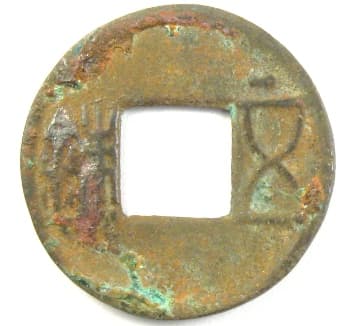
This Eastern Han wu zhu coin has a short bar or Chinese character "one" (yi 一) situated above the character wu (五) at the right of the square hole.
The diameter of the coin is 25.9 mm and the weight is 2.8 grams.

On this wu zhu, the "one" (yi 一) is located below the character wu (五) to the right of the square hole.
The coin has a diameter of 23.3 mm and a weight of 1.8 grams.
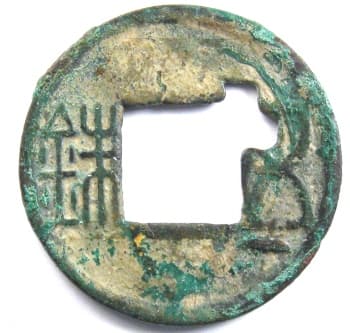
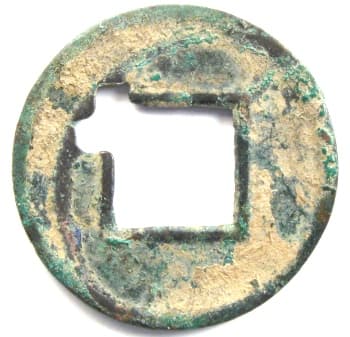 The obverse side (far left) of this wu zhu coin also has a
prominent "one" (yi 一)
located below the character wu
(五).
The obverse side (far left) of this wu zhu coin also has a
prominent "one" (yi 一)
located below the character wu
(五).However, the most distinctive characteristic of this coin is the hole which is not square.
Most non-square holes result from insufficient molten bronze flowing to certain parts of the mold. The borders of the holes, in these cases, tend to be very ragged, irregular, and uneven.
The Han Dynasty coin pictured here is fairly well-made and has a "number" symbol meaning it received special attention during its casting. The coin's unusual hole, while not square, is still too regular to have been formed accidentally.
There are documented reports of similar wu zhu coins having been found with unusual holes which appear to have been intentionally made. An article in the 1987 (7th issue) of the Chinese periodical "Shaanxi Finance" (shan xi jin rong 陕西金融) shows rubbings of several wu zhu coins with unusual holes found in a hoard. One coin is very similar to the one displayed here but has only one, in contrast to two, square-like projections extending beyond the normal border of the hole. The article also showed several coins which had triangular-shaped projections extending beyond the border of the inner hole.
The author of the article says that the coins did not show any indication that the holes were modified by force at some time after their casting. This is also the case with the coin displayed above.
Unfortunately, the author of the article was unable to propose what these distinctive holes may mean or symbolize.
These coins, with their modified square holes, may very well have been the precursor of the coins with "flower" or "rosette" holes which were to become fairly common by the time of the Song Dynasty (960-1279). For a detailed discussion of flower hole coins, including many examples, please see Chinese Coins with Flower (Rosette) Holes.
This coin has a diameter of 26.2 mm and a weight of 2.5 grams.

This wu zhu also has the Chinese character (yi 一) meaning "one".
In this case, however, the "one" is above the "zhu" (铢) character at the left of the hole.
The coin has a diameter of 26.2 mm and a weight of 2.4 grams.
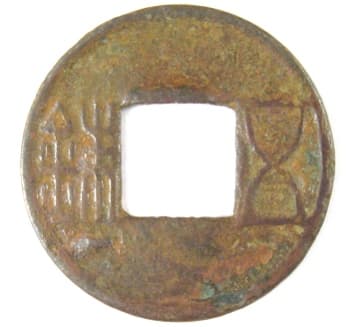
On this wu zhu, the character "one" (yi 一) is below the "zhu" (铢) character at the left of the hole.
The diameter is 25.8 mm and the weight is 2.7 grams.
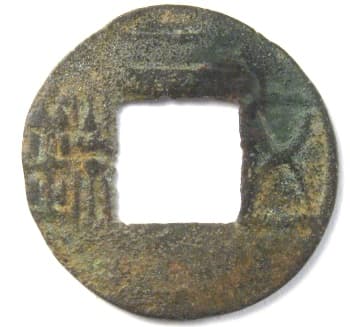
This wu zhu has two long horizontal lines above the square hole which may represent the Chinese character for "two" (er 二).
The diameter of the coin is 23.9 mm and the weight is 2.1 grams.
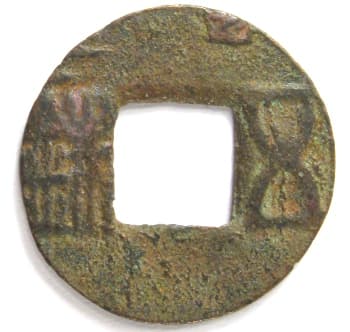
The wu zhu coin at the left has two short horizontal lines above the zhu (铢) character at the left of the square hole.
Two parallel lines represent the Chinese character for "two" (er 二).
The coin has a diameter of 23.3 mm and a weight of 1.8 grams.
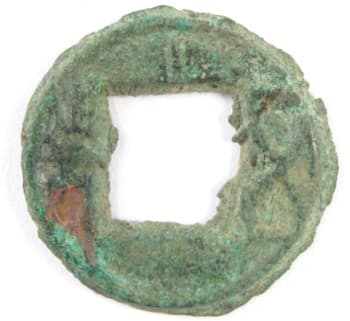
This coin was actually cast during the "Six Dynasties". In Chinese history, the "Six Dynasties" refers to the period of disunity, great social upheaval and warfare that existed from the fall of the Han Dynasty in 220 AD to the founding of the Sui Dynasty in 581 AD.
This time period included the Three Kingdoms (220-280 AD), the Western Jin Dynasty (265-316 AD), the Eastern Jin Dynasty (317-420 AD), and the Northern and Southern Dynasties (420-581 AD).
While some very refined coins were cast at this time, most coins were rather crude and inferior.
At the left is a wu zhu coin from this period.
The zhu (铢) character to the left of the hole has been simplified so that only its right side component (朱) appears.
What is unusual about this wu zhu are the two vertical bars incused just above the hole which probably represent the Chinese character for "two" (er 二).
The coin has a diameter of 22.3 mm and a weight of 2.5 grams.
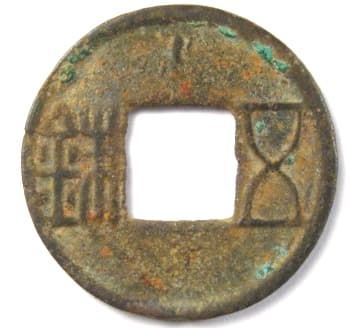
This Han Dynasty wu zhu coin has a short vertical line or bar above the square hole.
This symbol may represent the Chinese number "one" (yi 一).
The coin's diameter is 25.65 mm and the weight is 2.6 grams.
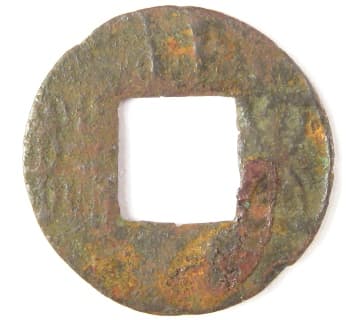
The obverse side of the Han wu zhu coin at the left also has two vertical lines in relief (yangwen 阳文) above the hole.
The two lines represent the Chinese number "two" (er 二) .
The diameter of the coin is 23.4 mm and the weight is 2.1 grams.
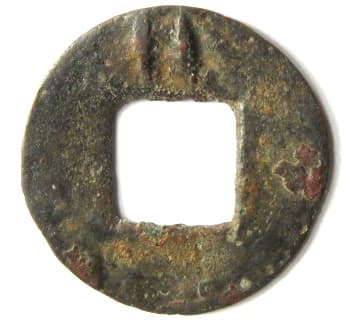
This wu zhu has two vertical lines in relief above the hole on the reverse side of the coin.
The two lines represent the number "two" in Chinese (er 二).
The coin has a diameter of 23 mm and a weight of 1.7 grams.
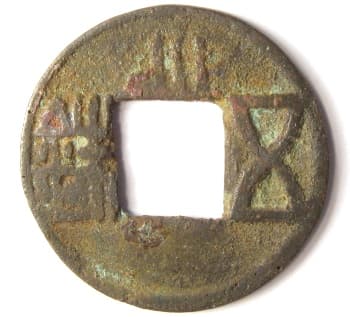
This Han Dynasty wu zhu has three vertical lines above the square hole.
Three lines represent the Chinese number "three" (san 三).
The diameter is 25.3 mm and the weight is 2.8 grams.
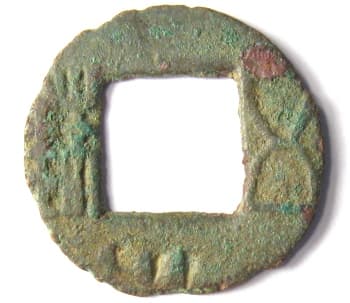
This wu zhu is similar to the one above except that there are three slanting lines located below the square hole.
The three lines are believed to represent the Chinese character for "three" (san 三).
The diameter is 22.5 mm and the weight is 1.6 grams.
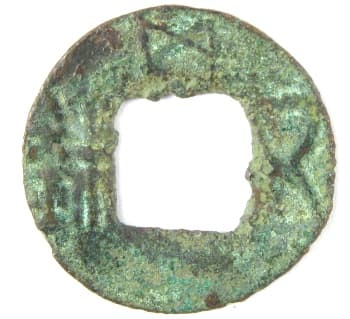
This wu zhu (五 铢) has a second wu (五) character meaning "five" above the square hole.
This second wu character is raised above the surface of the coin the same as the Chinese characters to the right and left of the hole.
This means the second wu character was intentionally engraved into the mold the same as the other characters.
The coin has a diameter of 23 mm and a weight of 2.2 grams.
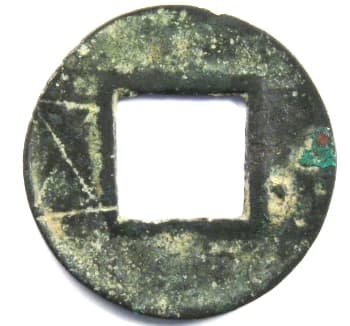
This wu zhu (五 铢) coin has another wu (五) character, meaning "five", located to the left of the square hole on the reverse side.
Unlike the coin above, this wu character is incused.
The coin has a diameter of 24 mm and a weight of 1.8 grams.
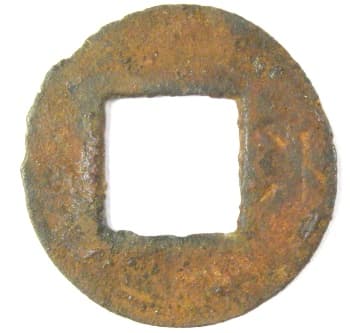
If you closely examine the reverse side of this wu zhu coin you will notice that there is the Chinese character liu (六), which means "six", incused at the right of the square hole.
The character is rotated 90 degrees clockwise.
The incused character was engraved into the coin sometime after it had been cast and was not a feature of the mold from which the coin was made.
The diameter of the coin 23.5 mm and the weight is 1.6 grams.
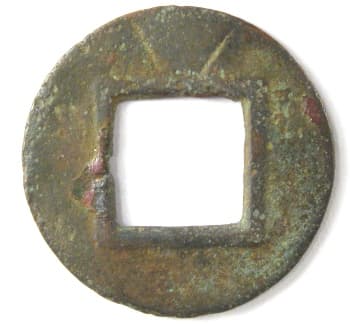
The reverse side of this wu zhu has the Chinese character ba (八), which means "eight", incused above the square hole.
In this example, the ba is upside down.
The coin has a diameter of 22.2 mm and a weight of 1.7 grams.
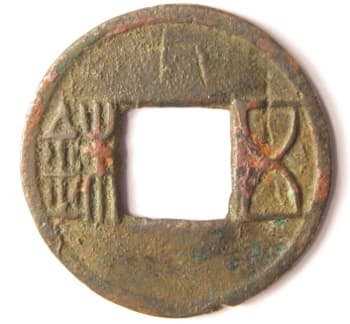
This wu zhu has the number "nine" (jiu 九) incused (carved) above the hole.
There is also an incused line running vertically through the wu (五) character on the right.
The coin's diameter is 26.2 mm and the weight is 3 grams.
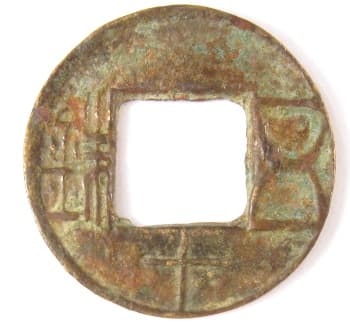
The Chinese coin at the left is a wu zhu cast during the Eastern Han.
The coin has a large and unusually well made Chinese character "ten" (shi 十) below the hole.
The diameter of the coin is 23 mm and the weight is 2.6 grams.

This unusual wu zhu has the Chinese character for "ten" (shi 十) above the square hole.
Below the hole are two dots or "stars".
The "stars" and the "ten" character are in relief meaning that they protrude above the coin surface and were part of the original design of the mold from which the coin was cast.
The coin has a diameter of 24.5 mm and a weight of 2.9 grams.
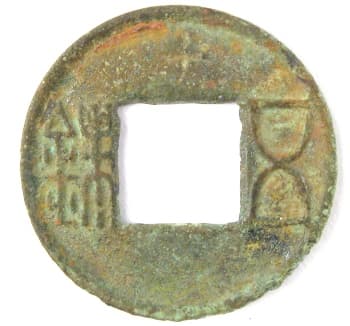
The Chinese coin at the left is another wu zhu with the character for "ten" (shi 十) incused above the square hole on the obverse side.
Unlike the above coin, however, the "ten" was engraved on this coin sometime after it was cast.
The diameter is 25.9 mm and the weight is 2.8 grams.
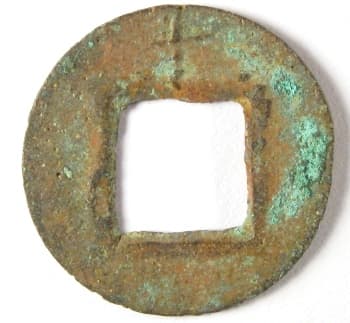
Above the hole on the reverse side of this wu zhu is the Chinese character "ten" (shi 十) which protrudes above the surface of the coin.
The coin has a diameter of 22 mm and a weight of 1.4 grams.
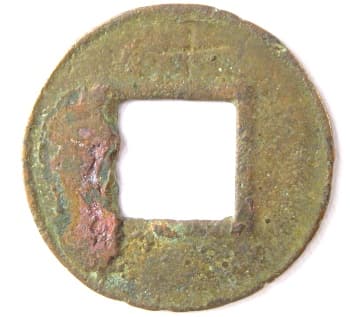
This is the reverse side of another wu zhu.
The Chinese character for "ten" (shi 十) is incused above the square hole.
The coin has a diameter of 24.5 mm and a weight of 2 grams.
Wu Zhu Coins with Rod Numbers (Numerals)
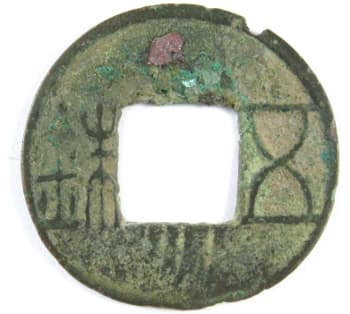 As
discussed in the section "Counting Rod Numbers" above,
this ancient form of writing numbers occasionally appears
on old Chinese coins.
As
discussed in the section "Counting Rod Numbers" above,
this ancient form of writing numbers occasionally appears
on old Chinese coins.The wu zhu coin at the left was cast during the Eastern Han Dynasty.
The distinctive feature of this coin is that there are four vertical bars or lines incused below the square hole.
"Incuse" means that the lines were cut, engraved or punched into the coin.
As seen in the section above on wu zhu coins displaying numbers, the Chinese numbers "one" (yi 一), "two" (er 二) and "three" (san 三) consist of one, two and three lines, respectively.
One might guess that the number "four" would consist of four lines.
This is not the case with modern Chinese but it was the case in the ancient rod numeral system.
It is, therefore, believed that the four lines on this wu zhu probably represent the number "four" in rod numerals.
The coins with one, two and three lines which I included in the section above may, in reality, also be rod numerals since they are written essentially the same as the characters in modern Chinese.
This coin has a diameter of 24.5 mm and a weight of 2.1 grams.
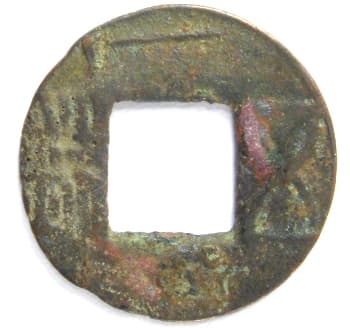
Above the hole of this wu zhu coin is a short vertical line intersected by a longer horizontal line.
This symbol, which resembles a "T" turned on its side, appears to be the rod number "six" as written in the old rod numeral system.
Rod numerals are believed to have been mainly used for doing calculations.
It is unclear why they sometimes appear on these very old Chinese coins.
This coin has a diameter of 22.6 mm and a weight of 1.9 grams.
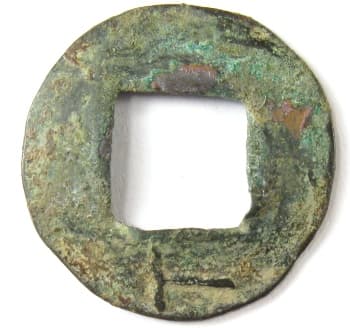
The reverse side of this wu zhu also has what appears to be a rod numeral "six" below the square hole.
The diameter of the coin is 23 mm and the weight is 1.7 grams.
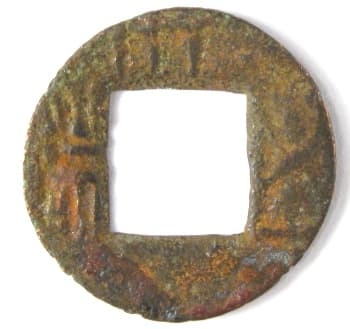 This wu zhu also displays
a rod numeral.
This wu zhu also displays
a rod numeral.Above the square hole, and protruding above the surface of the coin, is a horizontal line with three vertical lines underneath.
This is the rod numeral symbol for "8" (eight).
The coin is also unusual because of the two dots or stars inside the wu (五) character to the right of the hole. There is one dot in the upper half and one dot in the lower half of the character.
This gives the appearance of two eyes staring at you.
As mentioned above, this Eastern Han wu zhu variety with the "two eyes" is known as chang ming wu zhu (长明五铢).
The coin has a diameter of 21 mm and a weight of 1.4 grams.
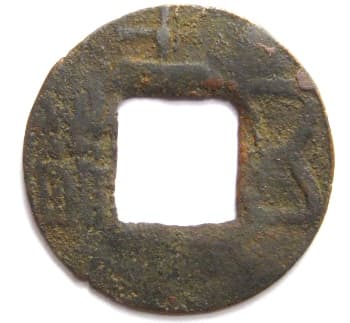
The symbol above the square hole on this wu zhu is very similar to a rod numeral.
It resembles the Chinese character shang (上), which means "up", except that the upper horizontal stroke is on the left instead of the right.
Some speculate that it is an alternative way of writing "six" in rod numerals, or perhaps it stands for "seven".
It may, in fact, not even be a number.
In any case, it is a very interesting symbol which will require further research.
This coin has a diameter of 23 mm and a weight of 1.7 grams.
Wu Zhu Coins with Lines
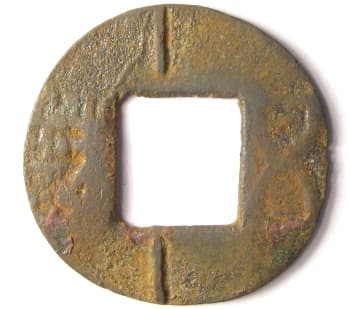
The obverse side of this wu zhu has a very prominent vertical line (shu 竖) above, and another below, the square hole.
The diameter is 22.5 mm and the weight is 1.8 grams.
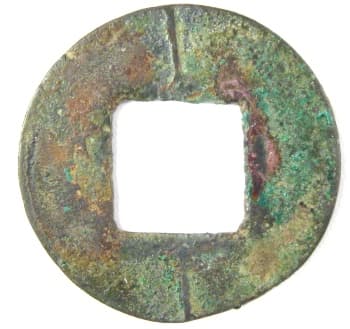
This is another Eastern Han Dynasty wu zhu coin.
In this case, there is a long vertical line above and another below the square hole on the reverse side.
Since the lines are raised above the coin surface, they had to have been intentionally included in the mold from which the coin was cast.
The diameter of the coin is 23 mm and the weight is 2 grams.
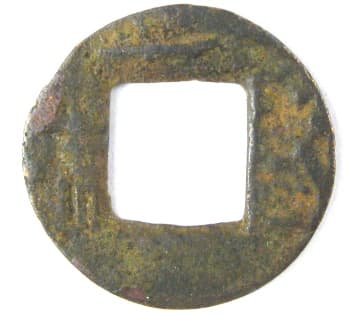
This is the obverse of another wu zhu.
The coin displays a long, prominent horizontal line above the square hole.
The diameter is 20.6 mm and the weight is 1.7 grams.
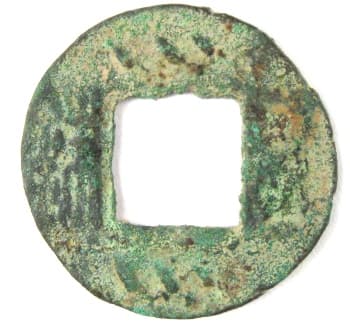
This wu zhu coin is distinctive in that it has three slanted lines above, and three slanted lines below, the square hole.
The slanting lines are raised above the surface.
The three lines above and the three lines below resemble the symbols on the Western Han ban liang displayed in the "Ban Liang Coins" section above.
The diameter of the coin is 23 mm and the weight is 1.8 grams.

The reverse side of this Eastern Han wu zhu has four lines or elongated dots to the left of the square hole.
The symbols are similar to those on the reverse of a Western Han ban liang above.
The coin has a diameter of 22.6 mm and a weight of 1.4 grams.

This is an example of a wu zhu that has four oblique lines extending outward from each corner of the hole to the rim on the reverse side.
In Chinese, this is referred to as si chu (四出). Si (四) means "four" and chu (出) means "going out".
The coin is also known as a "corner coin" (jiao qian 角钱).
This coin is believed to have been cast in the year 186 AD during the reign of Emperor Ling of the Eastern Han.
Cities in ancient China had walls built around them as a means of protection. It is said that the square hole of this coin represented the city and that the four lines going out represented wealth flowing out, portending the fall of the Han Dynasty in 220 AD.
The diameter of the coin is 25 mm and the weight is 3.1 grams.
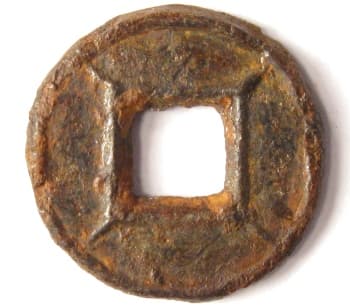
This is another example of a si chu (四出) or "corner" coin with four lines radiating outward from the hole.
This coin, however, is made of iron.
It was made in 523 AD during the reign of Emperor Wu of the Liang Dynasty (502-557 AD).
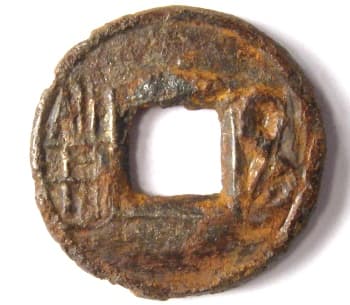
For reference purposes, this is the obverse side of this Southern Dynasties iron coin.
The coin has a diameter of 20.5 mm and a weight of 2.6 grams.
Wu Zhu Coins with Characters and Symbols
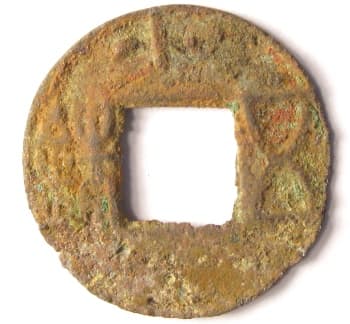
The coin at the left is an Eastern Han wu zhu with the Chinese character xiao (小), meaning "small", above the square hole.
As mentioned in the introduction, such characters as these may have indicated the area or limits in which these coins were intended to circulate.
The diameter of the coin is 24.3 mm and the weight is 2.1 grams.
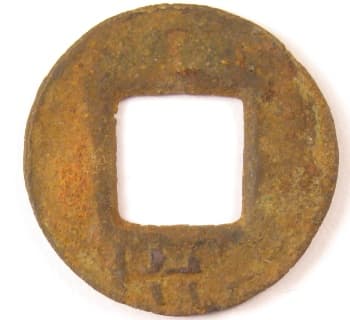
The reverse side of this Eastern Han wu zhu coin has the Chinese character wang (王), rotated 90 degrees, below the square hole.
Wang means "king" but is a common family name (surname) in China.
The wang character rises above the field of the coin which means it was a designed into the mold.
The coin has a diameter of 22.7 mm and a weight of 2 grams.
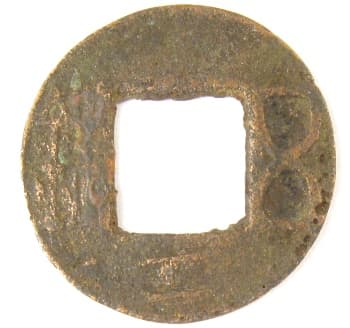
On the obverse side and below the square hole of this wu zhu is the Chinese character gong (工) meaning "work" or "industry".
The gong character is "in relief" (yangwen 阳文) meaning it was engraved into the mold the same as the other characters in the inscription.
The diameter of the coin is 23.7 mm and the weight is 2.3 grams.
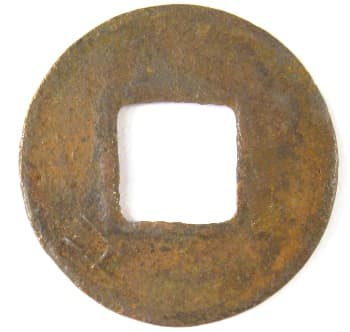
This is another wu zhu which displays a very distinct gong (工) character meaning "work" or "industry".
In this example, the gong is on the reverse side below the lower left corner of the square hole.
The diameter is 26 mm and the weight is 2.8 grams.
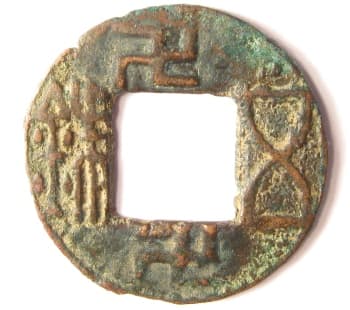
Another example of an old Chinese coin displaying auspicious symbols would be this wu zhu coin.
Both above and below the square hole are swastikas.
The swastika is a very old Asian symbol.
The diameter of this coin is 23.5 mm and the weight is 2.3 grams.
Wang Mang Coins
During his brief reign, he introduced four major currency reforms which resulted in 37 different kinds of money consisting of different substances (tortoise shell, cowries, gold, silver, copper), different patterns (knife, spade, coin), and different units (values of 1, 10, 20, 30, 40, 50, 100, 200, 300, 400, 500, 600, 700, 800, 900 and 1,000).
Not surprisingly, these reforms caused unprecedented disorder to the monetary system and brought tremendous misery to the people.
Wang Mang was assassinated in 23 AD.
These coins, nevertheless, tend to be of very high artistic value and the coin types exist in a number of varieties. The variations include symbols such as dots, blobs and radiating lines as well as the Chinese characters written in slightly different ways.
Because of their distinctive style, coins of the Wang Mang era were popularly used as the basis for charms and amulets. Several of these "Wang Mang" charms can be seen at Chinese Charms with Coin Inscriptions. Examples of his spade money are displayed at Chinese Spade Charms.
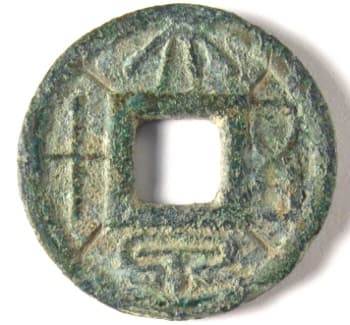
This is one example of a Wang Mang era coin with distinctive features.
The inscription is da quan wu shi (大泉五十) which means "Large Coin Fifty".
These coins were cast during the years 7-14 AD.
The unusual feature of this specific coin is that there are incused lines radiating from the four corners of the hole.
As explained in the section above concerning wu zhu coins, this feature is referred to as si chu (四出) with si (四) meaning "four" and chu (出) meaning "going out".
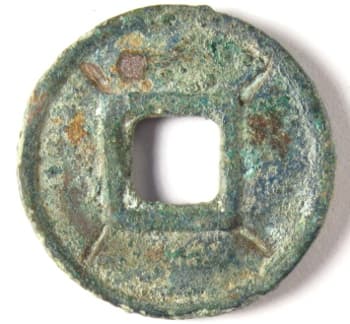
Unlike most coins, however, this same da quan wu shi also has incused lines radiating from the four corners of the hole on the reverse side.
The diameter of the coin is 27.5 mm and a weight of 5.8 grams.
To see examples of Chinese charms based on da quan wu shi coins, please visit Chinese Charms with Coin Inscriptions.
 This is another
example of a Wang Mang era coin with distinctive features.
This is another
example of a Wang Mang era coin with distinctive features.The inscription (legend) is read right to left as huo quan (货泉) and these coins were cast beginning in the year 14 AD.
Similar to the da quan wu shi shown above, this coin also has four lines protruding or radiating from the corners of the square hole.
Additionally, there are large blobs both above and below the square hole.
The meaning of these symbols is still unknown.
There is one additional feature of this coin. It is very thick and heavy. Because of their thickness and weight, these coins are variously known as "biscuit" (bing 饼) or "cake" coins.
This coin has a diameter of 23.3 mm and a weight of 7 grams.
Why Do Old Chinese Coins Have Auspicious Symbols?
There have been a number of theories as to why certain early symbols such as stars, moons and clouds started appearing on old Chinese coins.One theory bases the appearance of these symbols on the ancient Chinese belief of Yin Yang and the Five Elements. For an explanation of this theory please see Ancient Chinese Charm Symbols: Star, Moon, Cloud and Dragon.
Return to Ancient Chinese Charms and Coins